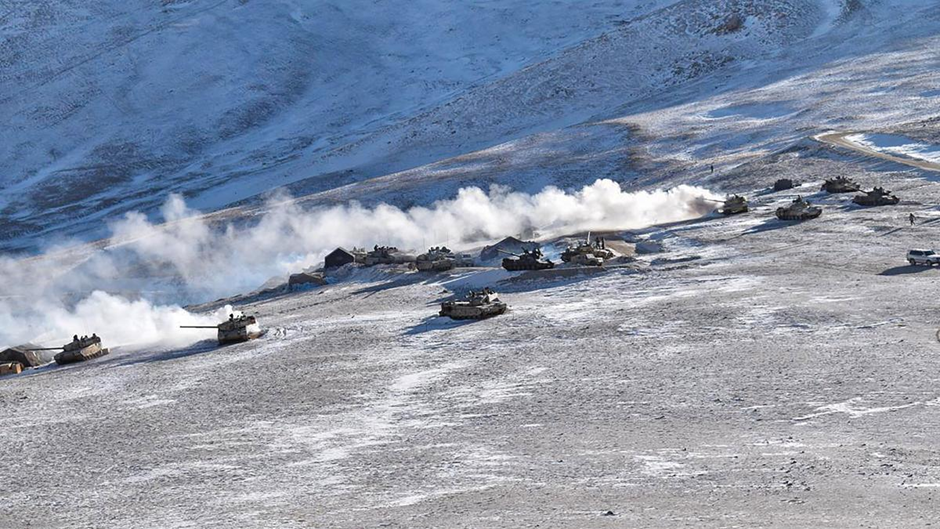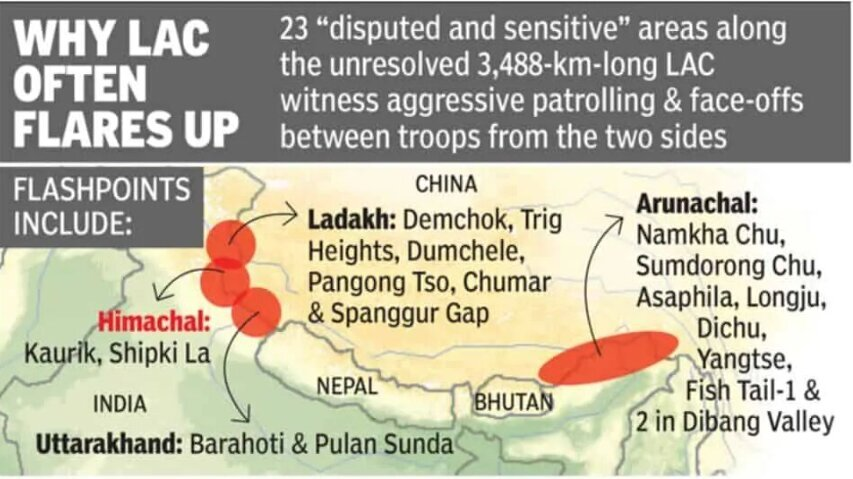- Courses
- GS Full Course 1 Year
- GS Full Course 2 Year
- GS Full Course 3 Year
- GS Full Course Till Selection
- Answer Alpha: Mains 2025 Mentorship
- MEP (Mains Enrichment Programme) Data, Facts
- Essay Target – 150+ Marks
- Online Program
- GS Recorded Course
- NCERT- First Ladder
- Polity
- Geography
- Economy
- Ancient, Medieval and Art & Culture AMAC
- Modern India, Post Independence & World History
- Environment
- Governance
- Science & Technology
- International Relations and Internal Security
- Disaster Management
- Ethics
- Current Affairs
- Indian Society and Social Issue
- CSAT
- 5 LAYERED ARJUNA Mentorship
- Public Administration Optional
- ABOUT US
- OUR TOPPERS
- TEST SERIES
- FREE STUDY MATERIAL
- VIDEOS
- CONTACT US
"Tensions and Talks: India-China Disengagement at the LAC"
"Tensions and Talks: India-China Disengagement at the LAC"
19-09-2024

Recently, India's External Affairs Minister announced that approximately 75% of disengagement issues with China along the Line of Actual Control (LAC) in Ladakh have been resolved. However, key areas like Demchok and the Depsang Plains remain unresolved.
Recent Developments in India-China Disengagement
Verified Disengagement
- Mutual Agreement: India and China have successfully disengaged from five friction points, including the Galwan Valley, Pangong Tso, and Gogra-Hot Springs.
- Ongoing Issues: Demchok and Depsang have seen no progress in disengagement over the last two years.
Diplomatic Engagement
- High-Level Meetings: Engagements between India’s National Security Advisor Ajit Doval and Chinese Foreign Minister Wang Yi have contributed to recent disengagement efforts.
- Upcoming Summits: The upcoming BRICS Summit in October 2024 in Kazan, Russia, is expected to foster further discussions between leaders of both nations.
Significance of Disengagement
- Constructive Dialogue: The latest meeting of the Working Mechanism for Consultation & Coordination on India-China Border Affairs was characterized as “frank and constructive,” indicating hope for resolving outstanding issues.
- New Terminology: The phrase “narrow down the differences” used in bilateral talks reflects a new approach and optimism for further disengagement.
Challenges in Disengagement
- Stalled Negotiations: Despite multiple talks, no agreement has been reached regarding Demchok and Depsang.
- Military Build-Up: Both nations continue to enhance infrastructure and troop deployments along the LAC, with around 50,000-60,000 troops stationed by each side.
- Risk of Escalation: The increased military capabilities and infrastructure could lead to miscalculations, heightening the potential for conflict.
Strategic Significance of Depsang Plains and Demchok
- Depsang Plains: This area is crucial for India as PLA control threatens access to the Siachen Glacier and exposes Indian positions to attacks from both China and Pakistan. The flat terrain makes it vulnerable to mechanized warfare.
- Demchok: This region is vital for monitoring Chinese activities in Aksai Chin and facilitates rapid military mobilization and logistics.
Key Areas in the India-China Standoff
- Pangong Lake Region: Frequent patrol encounters occur here, with territorial disputes centered around eight 'fingers' along the lake.
- Demchok Region: Increased Chinese military activity reported.
- Galwan River Basin: Chinese incursions detected near traditionally held Indian positions.
- Gogra Post: Military build-up by China has escalated tensions.
- Daulat Beg Oldie (DBO): Chinese encroachment in this strategic area threatens India's winter operations.

Triggers for China's Aggression Along the LAC
- Infrastructure Sensitivity: China’s aggressive posture may be a reaction to India's recent infrastructure developments, seen as a strategic threat.
- Element of Coercion: Current intrusions suggest a strategy to test India's responses and exert pressure.
- Wolf-Warrior Diplomacy: China’s confrontational diplomatic stance reflects its military approach along the LAC.
- Leverage Tactics: Activating border tensions may be a tactic to gain leverage in broader geopolitical contexts, including G20 and BRICS dynamics.
- Economic Pressures: Domestic economic challenges and strained international relations may influence China’s assertive actions.
Managing the China-India Border Dispute
- Clarification of LAC: Resuming efforts to clearly delineate the LAC could help avoid clashes.
- Buffer Zones: Permanent buffer zones should be established in frequently contested areas, with both sides committed to defending these zones.
- Adhering to Agreements: Compliance with existing bilateral agreements is crucial, including firearms bans and public reaffirmations of commitments.
- No-Patrol Zones: Designating no-patrol zones in contentious areas may help reduce friction.
- Drones Usage: Establishing parameters for drone surveillance can improve intelligence and reconnaissance efforts.
- Mutual Security Agreement: Developing agreements on acceptable troop levels and military capabilities near the border can enhance security.
- Awareness of Third-Party Relations: Both countries must consider how relations with other nations, such as the US for India and Pakistan for China, influence their interactions.
Conclusion
The India-China border dispute, rooted in colonial decisions, has intensified due to rising nationalism and assertiveness. The 2020 Ladakh clashes exacerbated tensions, leading to a state of "armed coexistence" characterized by distrust and military buildup. For lasting peace, both nations must improve engagement protocols, establish robust buffer zones, and enhance communication. High-level dialogue remains essential amidst ongoing strategic competition and complex geopolitical dynamics.
Must Check: Best IAS Coaching In Delhi
UPSC Prelims Result 2024 Out: Expected Cut Off & Other Details, UPSC Prelims 2024 Answer with Explanation, Daily Prelims Quiz, Daily Current Affairs, MONTHLY CURRENT AFFAIRS TOTAL (CAT) MAGAZINE, Best IAS Coaching Institute in Karol Bagh, Best IAS Coaching Institute in Delhi, Daily Mains Question Answer Practice, ENSURE IAS UPSC Toppers, UPSC Toppers Marksheet, Previous Year Interview Questions, UPSC Syllabus




